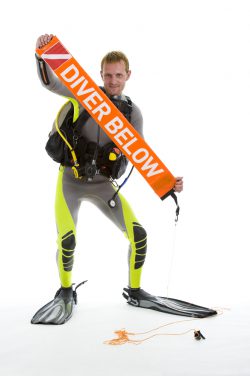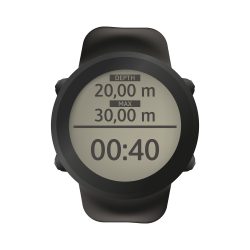You might have heard your instructor tell you how important it is to ascend from a scuba dive properly and that it would be quite risky to do an immediate ascent to the surface.
I’ll be telling you why we need to do a slow ascent, the effects of ascending too quickly and 6 great tips on properly ascending along with a great video to watch.
Decompression Sickness, Divers Disorder Condition

All our dives are decompression dives, meaning the experience a diver gets from surrounding pressure when ascending from a dive. It’s the process of eliminating inert gases from the diver’s body when ascending.
It doesn’t matter what type of diving you do, studies show DCS (Decompression Sickness) can and has happened even if you’re following the no-decompression limit. Stopping at approximately 15’ to do your safety stop has been proven to off-gas the excess nitrogen from your body BEFORE you near the surface, which is the greatest pressure change.
Any nitrogen that hasn’t been eliminated from the body can bubble out into your tissues, preventing the flow of blood and oxygen in the final stage of your ascent causing DCS.
These bubbles can cause nerve and tissue damage such as in the lungs causing lung overexpansion and in most severe cases can create death or paralysis if they go to the brain.
7 Tips to Properly Ascend From a Dive
Ascending properly from a dive is an important skill if you want to prevent any dive injuries.
1) Plan Your Dive Before You Take The Plunge.

Plan your dives for the day before you take the plunge underwater. Part of your ascend procedure depends on the type of diving you do.
Surface Marker Buoy. This visual signalling device once it reaches the surface, can be used to warn nearby boats that divers are close by. Have this attached to your BCD (Buoyancy Control Device).
The surface marker is attached to a line or reel from a spool you hold and deploy it underwater when you’re ready to ascend from a dive. Simply blow a couple of breaths into the opening or use your alternate air source to fill it with air.
2) Start Your Ascent Early.
It takes time to ascend and you want to make sure you have enough air to do your safety stop.
Monitoring the compressed air in your tank is a good indicator of when you should be preparing to end your dive.
3) Agree With Your Dive Buddy.

Don’t ascend to the surface without your dive buddy.
If you need to ascend earlier than your dive group, this is when you want to deploy your surface marker. Agree to ascend by giving each other the ‘thumbs up’ hand signal. Face each other as you begin your ascent.
4) Look Up, Neutrally Buoyant Ascents
As you slowly ascend, remain neutrally buoyant and be observant of your surroundings above you looking for objects that could potentially harm you.
It used to be that before, dumping the air from your BCD to become negatively buoyant was the procedure, but now thru studies, it was found that divers would hold their breath trying to fin upwards. This was causing potential entrapment of air in the lungs presenting possible lung injuries.
Rule Exception:
In shallower depths like 30’, it’s fine to use your fins and kick slowly against little negative buoyancy.
5) Slower Ascent Rate and Monitor.

Monitor how fast you ascend by positioning your dive computer in front of you so you can see how fast you are going up.
The rule is to ascend no faster than 30’/9m a minute which is 1 foot every 2 seconds.
Rule Exception
If you do a deep dive, deeper than 100’ and low on air or for physical reasons feeling hypothermia, doing a 30’ per minute ascent is simply not practical.
The best thing to do then is to do a faster ascent. The 60’/18m a minute ascent is definitely acceptable, in fact, years ago, this used to be the U.S. Navy standard.
For the remaining 60’, you should slow your rate of ascending to 30’ a minute.
6) Do Your Safety Stop.
When you reach 15’, stop and hover for 3 to 5 minutes before you finish your ascending. By doing this, you continue to off-gas the excess nitrogen in your body. This is where it’s important to have controlled buoyancy so you don’t start to descend.
Most often, dive boats have a rope or a line you can hang on to while doing your safety stop. This gives you time to look around for any sea creatures passing by you.
Under extreme conditions like a deep dive, 10 to 15 minutes is a recommendation.
7) Look Up.
Look up as you near the surface and observe your surroundings so you don’t get accidentally get hit by an object.
8) Surface, Establish Buoyancy.
Once you’re at the surface, establish buoyancy and wait for the dive boat to pick you up.
Ready To Do A Dive Trip?
I have exciting news for you! If you haven’t heard of Diviac, you can check them out here but I want to let you know Diviac is now PADI Travel, meaning they are now the largest dive travel agency network in the world giving tons of dive destinations information, bookings with liveaboards with full accommodation, meals, beverages and dives, dive resorts and dive shops. They have live chat 24/7 with dedicated experienced divers who understand your dive needs. A One-Stop booking platform!
Want to travel to exotic remote dive places from all 4 corners of the world?
==> Click here to see what PADI TRAVEL can offer you!
Do you have any stories you would like to share on any of your ascents from a dive or have any questions or comments, it would be awesome to hear from you.
Thanks for reading!
Monica
